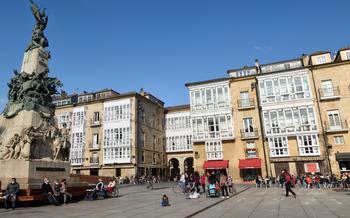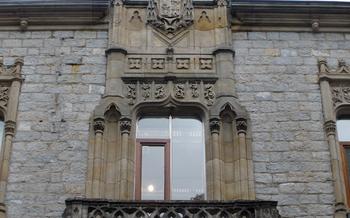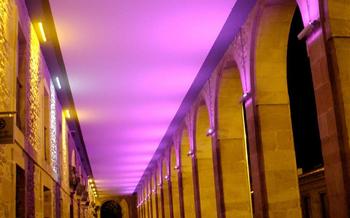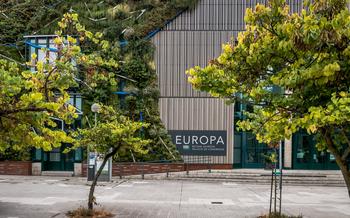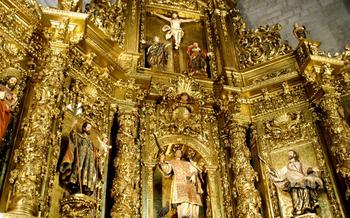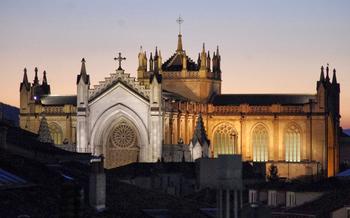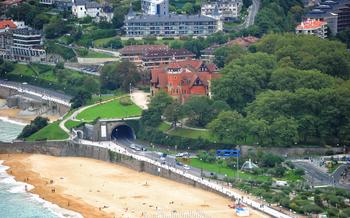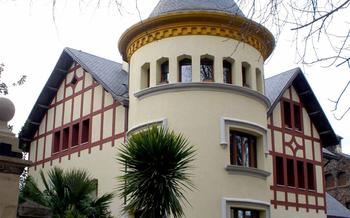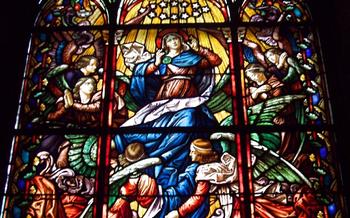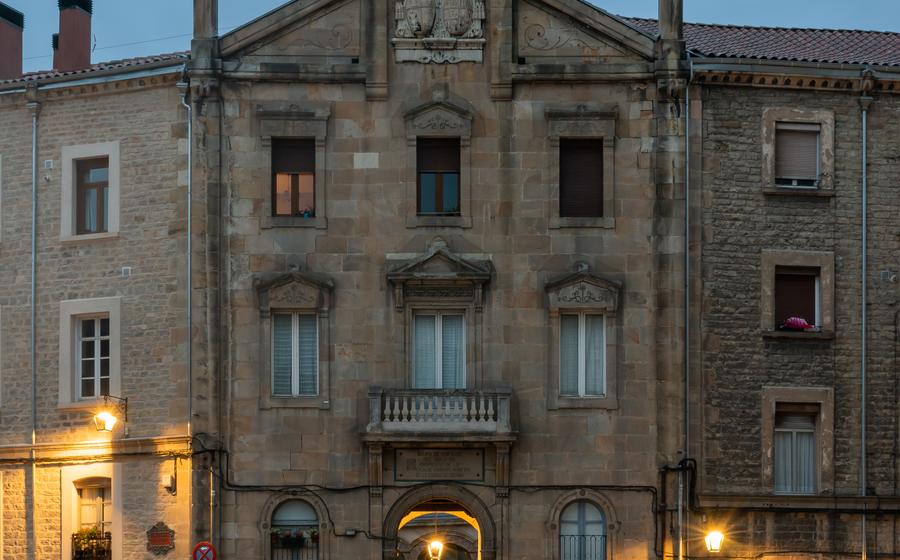
Santuario de Oro (sanctuary and viewpoint)
- Architectural Marvel
- Religious Importance
- Local Festivals
- Guided Tours
- Accessibility
- Getting There
- Accommodation Options
- Food and Drink
- Insider Tip: Unveiling the Hidden Chamber
Architectural Marvel
The Santuario de Oro stands as an architectural masterpiece, a testament to the fusion of Gothic and Renaissance styles. Its Gothic origins are evident in the pointed arches and intricate ribbed vaulting that adorn the interior. The Renaissance influence, on the other hand, manifests in the elegant proportions, classical pilasters, and harmonious facade.
One of the most striking features of the sanctuary is its tower, a soaring structure that dominates the skyline of Vitoria-Gasteiz. The tower, built in the 16th century, features a blend of Gothic and Renaissance elements, with its intricate carvings and delicate pinnacles. It offers breathtaking panoramic views of the city and the surrounding countryside, making it a popular destination for visitors seeking to capture the essence of the region.
Intricate carvings, intricate stained glass windows, and finely crafted sculptures further enhance the sanctuary's architectural beauty. Each detail has been carefully considered, creating a harmonious and awe-inspiring space that invites contemplation and reflection.
Religious Importance
The Santuario de Oro holds immense religious significance as a place of worship and pilgrimage. It serves as a sanctuary for the faithful and attracts numerous pilgrims who seek spiritual solace and guidance. The sanctuary is dedicated to the Virgin Mary, who is revered as the patron saint of Vitoria-Gasteiz. Pilgrims from all over the region flock to the sanctuary to pay homage to the Virgin and seek her blessings.
Throughout the year, the sanctuary hosts various religious ceremonies and events that draw large crowds of devotees. One of the most significant events is the annual pilgrimage of the Cofradía de la Virgen Blanca (Brotherhood of the White Virgin), which takes place on August 5th. During this procession, a statue of the Virgin Mary is carried through the streets of Vitoria-Gasteiz, accompanied by thousands of faithful who sing and pray in her honor.
The sanctuary is also a popular destination for weddings and baptisms, as couples and families seek the blessings of the Virgin Mary for their special occasions. Special masses and services are held regularly to accommodate the needs of the faithful and to foster a sense of community among the believers.
The Santuario de Oro stands as a testament to the deep religious devotion and cultural heritage of Vitoria-Gasteiz. Its enduring significance as a place of worship and pilgrimage continues to draw visitors from near and far, seeking spiritual fulfillment and a connection with the divine.
Local Festivals
Vitoria-Gasteiz is renowned for its vibrant festivals and celebrations that showcase the city's rich cultural heritage. Among these festivities, the Feast of the Assumption holds a special place, deeply intertwined with the Santuario de Oro. Every year on August 15th, the city erupts in a joyous celebration honoring the Virgin Mary's ascension into heaven. The streets come alive with processions, music, and traditional Basque dancing, creating an electrifying atmosphere.
The festivities kick off with a solemn mass held within the awe-inspiring sanctuary, followed by a grand procession that winds its way through the city's historic center. Locals and visitors alike don their finest attire, carrying candles and colorful banners, as they accompany the revered statue of the Virgin Mary. The procession is a mesmerizing spectacle, a testament to the deep devotion and pride of the Basque people.
Throughout the day, the city pulsates with music and dance. Traditional Basque folk groups perform in the squares and streets, captivating audiences with their lively tunes and intricate steps. The air fills with the infectious rhythm of the txalaparta, a Basque percussion instrument, while dancers twirl and stomp in a mesmerizing display of Basque cultural heritage.
The Feast of the Assumption is not just a religious celebration; it's a vibrant expression of Basque identity and community spirit. Locals and visitors come together to honor their patron saint, celebrate their cultural traditions, and revel in the joyous atmosphere that permeates the city during this special time.
Guided Tours
To fully appreciate the history, architecture, and significance of the Santuario de Oro, consider joining a guided tour. These tours are led by knowledgeable guides who can provide in-depth insights into the sanctuary's past and present. Various tour options are available, catering to different interests and preferences.
Standard tours typically cover the history and architectural highlights of the sanctuary, including the Gothic-Renaissance style, the intricate carvings, and the stunning stained glass windows. For those interested in the religious significance of the site, specialized tours focus on the pilgrimage aspect, the symbolism of the sanctuary's iconography, and the stories of pilgrims who have passed through its doors.
For an immersive experience, book a night tour of the Santuario de Oro. As darkness envelops the surroundings, the sanctuary takes on a new ambiance, creating a mystical and awe-inspiring atmosphere. Night tours often include storytelling, legends, and insights into the spiritual significance of the site.
Whether you prefer a standard daytime tour, a specialized pilgrimage tour, or an enchanting night tour, the Santuario de Oro's guided tours offer a deeper understanding and appreciation of this remarkable sanctuary.
Accessibility
The Santuario de Oro is committed to ensuring that all visitors, including those with disabilities, have a fulfilling and enjoyable experience. The sanctuary is wheelchair accessible, with ramps and elevators providing easy access to all areas. Designated parking spaces for visitors with disabilities are available near the entrance. Additionally, the sanctuary provides wheelchairs for those who may require assistance. Visitors with visual impairments can request audio guides or tactile maps to enhance their visit. For visitors who are deaf or hard of hearing, sign language interpreters can be arranged upon request. The Santuario de Oro strives to create an inclusive environment where everyone feels welcome and able to fully appreciate the beauty and significance of this sacred site.
Getting There
Reaching the Santuario de Oro is a breeze, thanks to the well-connected public transportation system in Vitoria-Gasteiz. Several bus routes conveniently stop near the sanctuary, making it accessible to visitors from all corners of the city. Whether you prefer the flexibility of the bus or the convenience of your own vehicle, getting to the Santuario de Oro is a hassle-free experience.
For those arriving by car, ample parking options are available in the vicinity of the sanctuary. Take advantage of the designated parking areas to ensure your vehicle's safety and enjoy a stress-free visit to this stunning religious landmark.
Accommodation Options
Vitoria-Gasteiz offers a range of accommodation options to suit different budgets and preferences. For those seeking convenience and proximity to the Santuario de Oro, several hotels and guesthouses are located within walking distance. The Hotel Santuario de Oro, situated right at the foot of the sanctuary, offers stunning views and easy access to the religious site. The Hotel Silken Ciudad de Vitoria, a modern and stylish option, is just a short stroll away, providing comfortable accommodations and convenient amenities. For budget-conscious travelers, the Albergue de Peregrinos de Vitoria, a traditional pilgrim hostel, offers simple yet comfortable lodgings, allowing pilgrims to experience the camaraderie of the Camino.
Food and Drink
When visiting Vitoria-Gasteiz and the Santuario de Oro, immerse yourself in the delectable local cuisine. Basque Country is renowned for its culinary prowess, and the city offers a diverse range of dining options. For an authentic experience, venture into the atmospheric Old Town and explore the traditional pintxos bars. Indulge in these bite-sized culinary creations, often served on small slices of bread, which showcase the region's flavors. From classic pintxos like gildas (skewers with olives, anchovies, and peppers) to more elaborate creations, each bite is a journey of taste.
For a memorable dining experience, savor the traditional Basque dish of bacalao al pil pil. This exquisite dish features tender codfish cooked in a rich, flavorful sauce made from olive oil, garlic, and chili peppers. The result is a harmonious blend of textures and flavors that will tantalize your taste buds.
Whether you prefer casual eateries or fine-dining establishments, Vitoria-Gasteiz has something to satisfy every palate. Don't miss the opportunity to sample the local wines, produced in the nearby Rioja region, which complement the local cuisine perfectly.
Insider Tip: Unveiling the Hidden Chamber
Beyond the main altar of the Santuario de Oro lies a hidden chamber, accessible through a discreet door. This secret space, known as the Sacristy, houses a collection of priceless religious artifacts, including ornate chalices, intricate reliquaries, and ancient manuscripts. Visitors who venture into this sacred chamber are granted a glimpse into the rich history and spiritual significance of the sanctuary. Remember to inquire about guided tours or special permissions to access this hidden gem, as it is not always open to the public.
